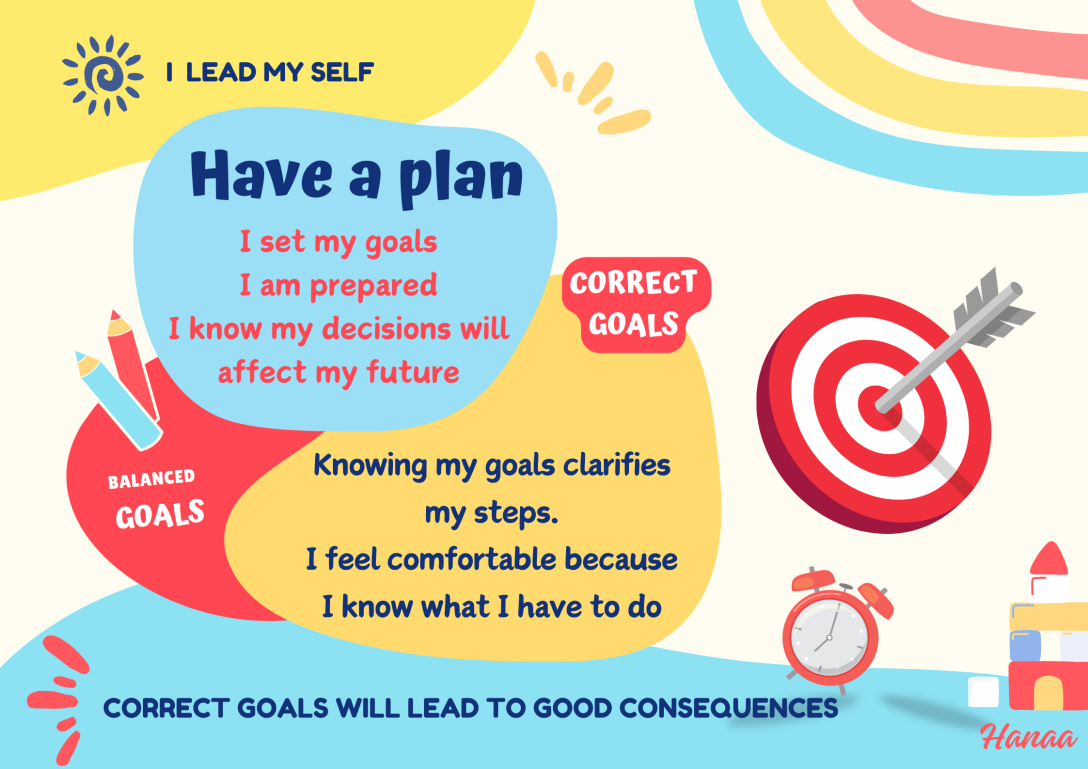Knowing what you want to achieve helps you make decisions and choices along the way.
Habit 2 is all about “Starting with the end in mind.” This means you should visualize the end result of what you want to achieve before you begin.
Setting a goal is an essential skill for achieving success.
Once you have set your goal, it’s important to break it down into smaller, more manageable pieces.

For instance, suppose you have a jigsaw puzzle. You would first look at the picture on the box and then sort the pieces. Perhaps you would start with the edges and then find all the pieces of the same color, and so on, step by step until the puzzle is complete. This approach will help you achieve your goal more efficiently and effectively.

For example, reading a recipe before cooking or looking at a map before going on a trip is starting with the end in mind.
When I set a goal,
I succeed in preparing myself for it at the right time and with the right tools.
We should train our children to imagine themselves at the end of the road, happy with what they’ve achieved. Goals should be realistic and offer a level of challenge that encourages them to reach their fullest potential.

Ways to instill habit 2 at home:
Share stories from your life, or even from your workday, where you had a goal or task you accomplished.
What steps did you take to achieve it?
How did breaking it down make the execution easier?
Point to examples from your child’s life, like riding a bike, tying shoes, or another skill.
Celebrate achieving your goal.
Tell your children that we learn this habit from the Quran which says: “But whoever desires the Hereafter and exerts the effort due to it while he is a believer – it is those whose effort is ever appreciated [by Allah]..” Surah Al-Isra
(وَمَنْ أَرَادَ الْآخِرَةَ وَسَعَىٰ لَهَا سَعْيَهَا وَهُوَ مُؤْمِنٌ فَأُولَٰئِكَ كَانَ سَعْيُهُمْ مَشْكُورًا) سورة الإسراء
Every Muslim should strive for Paradise and aim to please God through obedience and righteous deeds.
Also, it says, “And whoever seeks the reward of this world, We give him of it, and whoever seeks the reward of the hereafter, We give him of it.” Al-Imran
(وَمَنْ يُرِدْ ثَوَابَ الدُّنْيَا نُؤْتِهِ مِنْهَا وَمَنْ يُرِدْ ثَوَابَ الْآخِرَةِ نُؤْتِهِ منها) آل عمران
The goal you set in front of you will show you the way to reach it.
Clear small goals are very useful for kids.
Example 1: To read 50 stories during the vacation. I’ll divide it into reading one illustrated story every day except on weekends when I go out with my family.
Example 2: If there’s something special they want to buy, help your child plan how much money they’ll need to save and how long it will take. Discuss ideas to earn extra money, like doing extra chores and helping at home.
Example 3: You have a goal to finish reading the Quran in Ramadan. So, you’ll read one part every day.
Example4: You have a goal to be consistent with the five daily prayers:
You remind your parents to alert you when it’s prayer time.
You download the Adhan app on your phone or your parent’s phone.
You create a schedule to check how committed you are and track your progress toward achieving your goal.
Example 5: Look to the future. Since they were little, adults ask kids, “What do you want to be when you grow up?”
Help your child identify the interest, then encourage activities, skills, books, or other opportunities that support this interest. Explain to them how these small steps can lead them to bigger opportunities to use this interest in various ways in their adult life. They might change their minds later. This is normal and expected. Assure them that you support them if they want to make a change.
Creating a Family Vision and Message:
What kind of family do you want to be?
What are your family’s values?
What is your ultimate family goal?
Discussing and writing this together as a family can help guide the whole family in a more positive direction. It can be simple, like “Being kind to each other all the time so everyone always loves coming to our home,” or it can be other goals. Whatever your family chooses, it creates a positive image that everyone can feel a part of. Make sure to include all family members in creating the vision and message.
Start by following these steps:
- Discuss the following questions with your family:
- What do we want our family to be known for?
- How do we treat each other?
- What unique contributions can we make?
- What big goals do we want to achieve?
- What talents and skills do we have?
Share ideas and words to include in the mission statement. Remember, there are no bad ideas.
Start crafting your statement, but remember, it doesn’t have to be finished in one session. It can be a work in progress until everyone is happy with the result. Display it prominently in your home and encourage the whole family to consider it when making decisions or facing conflicts.
Here’s an example:
“Our family’s mission is to create a place of order, love, happiness, and relaxation, providing opportunities for each person to become responsible, independent, and interdependent, in pursuit of meaningful goals.”
Activities for Young Children:
Create a collage of “wants” and “needs” with your child. Cut out pictures from various items (toys, candy, vegetables, cleaning supplies, appliances, books, etc.) from a magazine and draw two columns, one for “wants” and one for “needs.” Then have your child glue each picture under the correct column of “wants” or “needs.”
Discuss why they chose to place the items in the respective columns. Then, identify steps to fulfill these wants and needs.
Activities for Teenagers:
- Discuss your children’s career aspirations and help them identify the key skills necessary for success in that profession.
Encourage them to meet with a school counselor to discuss their career aspirations and the required skills, and to plan the educational path that will achieve it.
Identify and encourage extracurricular activities that support your children’s goals.
Help your children research training and activities related to their goals. - Older children may have more costly “needs,” but they also can earn more money. Ask your teenager if there’s something specific they want to buy, then help them plan how much money they’ll need to save and how long it will take. Discuss ideas for earning extra money, like getting a part-time job or doing additional tasks.
- Create a family budget and plan.
- Have the children plan how to spend and save their allowances.
Be careful to use the following words when dealing with your children daily:
- “What do you plan to do with this once you finish?”
- “Can we break this down into smaller, manageable steps?”
- “Do you need any help from me to succeed?”
- “What are the other steps we need to take to reach this goal?”
- “Okay, what do you want more, this (immediate limited result) or your goal (the big goal the child set and felt the pleasure of achieving something significant)?”
They can watch the following video:
Tell them about the story of the Prophet’s migration:
The Prophet Muhammad (peace be upon him) and Abu Bakr planned carefully for their journey. They prepared 2 camels until the suitable day for migration came.
He selected individuals based on their specific skills and abilities. For example, he chose Abdullah bin Abi Bakr to gather and bring him the news, Aamer bin Fuhaira to cover their tracks by walking with the sheep in the area of footprints., and Asmaa bint Abi Bakr to provide food and supplies to Hira where they were staying.
Prophet Muhammad (peace be upon him) left “Ali bin Abi Talib to return the entrusted items to their owners.”
Interestingly, he even sought help from a non-Muslim, Abdullah bin Ariqat, because of his expertise, trustworthiness, and knowledge of unconventional roads to guide them to Medina.
During the Battle of Badr:
In the Battle of Badr, there were about three hundred and ten Muslims. They had some horsemen and seventy camels with them. The Quraysh army had one thousand men and two hundred horses, which means they were roughly three times larger than the Muslim army in terms of numbers.
Prophet Mohamed put a plan to face this situation, He organized his group with archers at the front, followed by individuals who carry spears, and then swordsmen and horsemen. This tactical arrangement allowed them to deal with Bigger groups of enemies effectively.
Khalid ibn Walid
Talk about the companions of the Prophet and how Khalid ibn Walid deceived the Roman army during the Battle of Mu’tah. Three thousand Muslims faced two hundred thousand Romans and their Arab allies.
Explain how Khalid implemented his plan:
- He had the horses run all night on the battleground to raise a thick cloud of dust, making the Romans think that reinforcements were coming for the Muslims.
- He rearranged the army’s formation, making the left look like the right and the right look like the left. When the Romans saw this change in the morning, along with the altered banners and faces, they believed that significant reinforcements had arrived for the Muslims.
- Behind the army, at a distance, Khalid stationed a group of Muslim soldiers on a hill, spread out over a wide area, with their only task being to raise dust clouds to signal continuous reinforcement for the Muslims.
- On the day after the battle, Khalid gradually began to withdraw his army deeper into the desert, making the Romans believe that he was leading them into an ambush. They hesitated to pursue him, standing at the plains of Mu’tah, watching Khalid’s retreat without daring to attack him.
Khalid ibn Walid succeeded in his plan and safely withdrew his entire army into the depths of the desert before beginning the journey back to the city of Medina.
And let’s not forget the plan of the conquest of Constantinople:
Muhammad al-Fatih devised a brilliant plan that amazed orientalists, who said: “This man surpassed Alexander the Great and Napoleon.” After identifying the reasons hindering the conquest, Muhammad al-Fatih tackled them one by one.
Regarding the first obstacle, which was the absence of a Muslim fortress in front of the walls of Constantinople, he decided to build a fortress in a time frame of no more than three months. He gathered skilled and capable workers, motivating them by saying, “Would you like to be followers of the Messenger of Allah on the Day of Judgment… and be among those about whom it was said, ‘What a great army that is’?” The workers were motivated and completed the work in record time, constructing a magnificent fortress that would have taken a full year to build in just three months.
Regarding the second obstacle…, which was the lack of suitable cannons to breach the city walls, al-Fatih demonstrated the wisdom of the believer’s quest, He brought in the skilled Hungarian engineer “Orban,” who was known to have prepared cannons capable of breaching the walls of Constantinople. Orban had offered his services to the Emperor of Constantinople, but he was not given the reward he desired. So he came to al-Fatih, who received him warmly and generously provided him with funds. Al-Fatih knew how to make the best use of him, facilitating all the means for him to complete his invention, and providing him with the necessary equipment and technicians. Orban, along with other Ottoman engineers overseen by al-Fatih himself, began manufacturing the cannons. In less than three months, Orban had produced three cannons, one of which was a colossal giant weighing seven hundred tons, with each shell weighing one thousand and five hundred kilograms! Its range reached a thousand miles, pulled by sixty oxen with the assistance of four hundred strong men, two hundred on each side.
Regarding the chain across the Gulf, this chain obstructed the entry of the Muslim fleet into the Gulf until it reached the walls. For this reason, al-Fatih decided to undertake a unique endeavor. He created a passage through which ships could navigate through the mountain directly into the Gulf, bypassing the chain. This distance was estimated to be three miles. He used lubricated wooden tracks to facilitate the movement of ships, employing seventy ships, hundreds of bulls, and hundreds of men for their propulsion. The transfer of the ships took place from after sunset until just before dawn, surprising the Romans. The siege lasted fifty-three days until Allah granted victory to the army. Thus, knowledge was a path to planning and a crucial factor in the conquest of Constantinople, realizing that dream for the Muslims.

